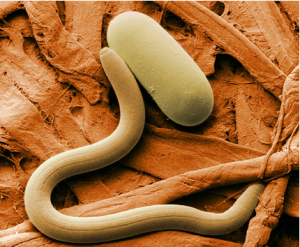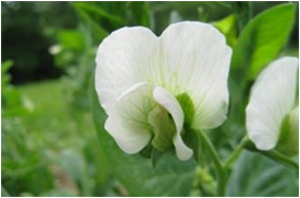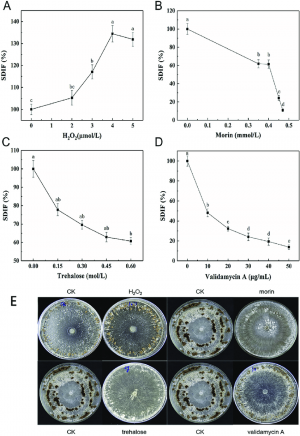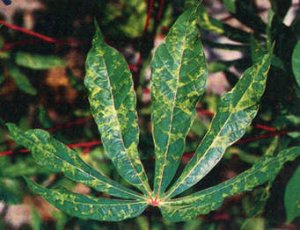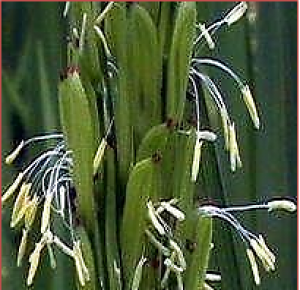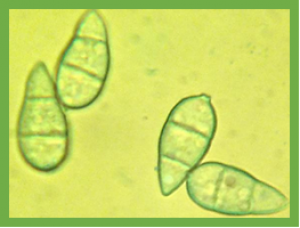Soybean cultivars, susceptible to the fungus Fusarium virguliforme, which causes sudden death syndrome (SDS), and to the soybean cyst nematode (SCN) (Heterodera glycines), suffer yield losses valued over a billion dollars annually. Both pathogens may occur in the same production fields. Planting of cultivars genetically resistant to both pathogens is considered one of the most effective means to control the two pathogens. The objective of the study was to map quantitative trait loci (QTL) underlying SDS and SCN resistances
Legumes form root nodules to house beneficial nitrogen-fixing rhizobia bacteria. However, nodulation is resource demanding; hence, legumes evolved a systemic signalling mechanism, called Autoregulation of Nodulation (AON), to control nodule numbers. AON begins with the production of CLE peptides in the root, which are predicted to be glycosylated, transported to the shoot, and perceived.
Genetically engineered (GE) rice lines expressing Lepidoptera‐active insecticidal cry genes from the bacterium Bacillus thuringiensis (Bt) have been developed in China. Field surveys indicated that Bt rice harbours fewer rice planthoppers than non‐Bt rice although planthoppers are not sensitive to the produced Bt Cry proteins. The mechanisms underlying this phenomenon remain unknown. Here, we show that the low numbers of planthoppers on Bt rice are associated with reduced caterpillar damage. In laboratory and field‐cage experiments, the rice planthopper Nilapavata lugens had no feeding preference for undamaged Bt or non‐Bt plants but exhibited a strong preference for caterpillar‐damaged plants whether Bt or non‐Bt.
Xanthomonas oryzae pv. oryzae (Xoo), causal agent of bacterial blight (BB) of rice, uses transcription activator-like effectors (TALEs) to interact with the basal transcription factor gama subunit OsTFIIAγ5 (Xa5) and activates transcription of host genes. However, how OsTFIIAγ1, the other OsTFIIAγ protein, functions in the presence of TALEs remains unclear. In this study, we show that OsTFIIAγ1 plays a compensatory role in the absence of Xa5. The expression of OsTFIIAγ1, which is activated by TALE PthXo7, increased the expression of host genes targeted by avirulent and virulent TALEs.
Rhizoctonia solani AG-1 IA is the causal agent of rice sheath blight (RSB) and causes severe economic losses in rice-growing regions around the world. The sclerotia play an important role in the disease cycle of RSB. In this study, we report the effects of reactive oxygen species (ROS) and trehalose on the sclerotial development of R. solani AG-1 IA. Correlation was found between the level of ROS in R. solani AG-1 IA and sclerotial development. Moreover, we have shown the change of ROS-related enzymatic activities and oxidative burst occurs at the sclerotial initial stage.
Cassava is an important crop in Africa that is widely cultivated for its starchy tuberous root, which constitutes a major source of dietary carbohydrates. Cassava mosaic disease (CMD) is the most devastating disease affecting cassava in Africa and causes enormous losses in yield. In Benin, specifically, cultivars resistant to CMD are not commonly planted, and even when CMD is observed in fields, farmers do not implement control measures, presumably because they lack proper knowledge and training. Our study aimed to evaluate farmers' knowledge of CMD to determine whether there is consistency between farmers' criteria for selecting cassava cultivars and the currently CMD-recommended cassava varieties.
Drought has been one of the most important limiting factors for crop production, which deleteriously affects food security worldwide. The main objective of the present study was to quantitatively assess the effect of drought on the agronomic traits (e.g., plant height, biomass, yield, and yield components) of rice and wheat in combination with several moderators (e.g., drought stress intensity, rooting environment, and growth stage) using a meta-analysis study. The database was created from 55 published studies on rice and 60 published studies on wheat.
Among their responses to microbial infection, plants deploy an arsenal of natural antibiotic products. These historically have been identified on the basis of their antibiotic activity in vitro, which leaves open the question of their relevance to defense in planta. The vast majority of such natural products from the important crop plant rice (Oryza sativa) are diterpenoids whose biosynthesis proceeds via either ent- or syn- copalyl diphosphate (CPP) intermediates, and which were isolated on the basis of their antibiotic activity against the fungal blast pathogen Magnaporthe oryzae.
Plant disease outbreaks caused by fungi are a chronic threat to global food security. A prime case is blast disease, which is caused by the ascomycete fungus Magnaporthe oryzae (syn. Pyricularia oryzae), which is infamous as the most destructive disease of the staple crop rice. However, despite its Linnaean binomial name, M. oryzae is a multihost pathogen that infects more than 50 species of grasses. A timely study by P.
Despite the importance of liverworts as the earliest diverging land plant lineage to support fungal symbiosis, it is unknown whether filamentous pathogens can establish intracellular interactions within living cells of these nonvascular plants. Here, we demonstrate that an oomycete pathogen invades Marchantia polymorpha and related liverworts to form intracellular infection structures inside cells of the photosynthetic layer.


 Curently online :
Curently online :
 Total visitors :
Total visitors :
